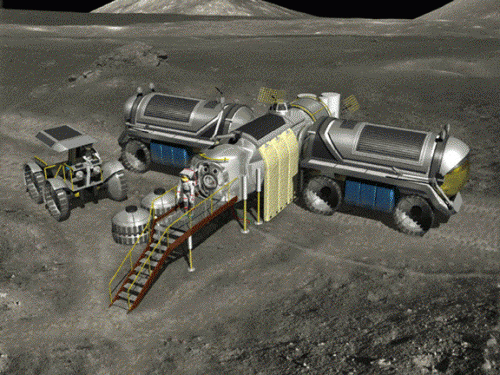
When Eugene Cernan, commander of the Apollo 17 mission, headed back up the ladder of the Lunar Module on December 14, 1972, he became the last human to date to walk on the Moon. Almost every U.S. Administration since that time has announced America’s intention to go back to our nearest celestial neighbor and establish a permanent presence there, but more than 40 years have gone by since the last bootprint was made in the lunar dust. What are the prospects for a return any time soon?
NASA would like to go back to the Moon, but is seriously cash-strapped. In any case, the space agency’s primary focus in human spaceflight beyond low-Earth orbit since 2010 has been a crewed trip to a near-Earth asteroid. This enterprise, in turn, rests on the development of the giant Space Launch System (SLS) and the Orion crew capsule. Both could, in principle, form the basis of a series of lunar landing missions, but, with the asteroid goal in mind, the likeliest scenario for now would seem to be some kind of preliminary activity in near-lunar space or at the Earth-Moon L2 point (a gravitational balance point), which could serve as a staging post for the asteroid shot.
China and several other nations have announced a broad intent to go to the Moon and, beyond that, setting up bases and possibly commercial operations such as mining there. However, as in the case of other future manned objectives, such as mining the asteroids and reaching Mars, it may be that private operators get there first.

Spearheading the drive to put fee-paying passengers on the Moon is startup company Golden Spike, founded by ex-NASA heavyweights Alan Stern (the Agency’s associate administrator for science in 2007-2008) and Gerry Griffin (former Johnson Space Center director). Using mostly current rockets, plus some commissioned developments in capsule and lunar lander technology, Golden Spike aims to reach the lunar surface by 2020, and says it will be offering its services to “governmental agencies, companies, and individuals in the United States and around the world—for science, for commerce, for tourism, for entertainment engagement, and for education.”
As presently envisaged, a Golden Spike mission would begin with the launch, by some proven rocket systems, of the lunar lander and, separately, a lunar transfer vehicle (LTV). These elements would be linked up in Earth orbit and then the LTV would boost the lander toward the Moon and place it in lunar orbit before itself returning to Earth. Next the LTV would be refuelled in orbit and the two-person crew vehicle would be launched for the LTV to dock with and propel into lunar orbit. The crew would then transfer to the lander for their lunar excursion. Finally, the crew vehicle would fire its own engine to return for a splashdown on Earth, while the lander remained in lunar orbit, awaiting its next passengers.
Golden Spike’s estimated price tag is a hefty one—around $1.4 billion for a two-person flight. But it may not be beyond the reach of some wealthy individuals, companies, or ambitious governments eager to earn some national prestige. And with other NewSpace firms lining up to explore and exploit the final frontier, it won’t be alone in eyeing a speedy return to the Moon.
Missions » Apollo »




We did it once, so you’d think we could do it again? When and how indeed.
The problem is certainly not the technology. We can do that.
I know this is controversial, but it really isn’t the cost either. (Hold off the stoning. I will explain.)
It has to be economical or it will not go forward. People rightly call ‘one of’ missions a stunt. Progress requires profit.
Is there any profit potential?
I don’t believe there is anything on the moon worth mining for export to earth. People can argue that, but I don’t see a business case that closes. If there was one, somebody would do it. That’s how profit motivates.
42% of lunar regolith is oxygen (if my memory serves.) Is that profitable in earth orbit when the cost of LOX in LEO is thousands of dollars per pound?
Perhaps, but much more so if it’s used to go BEO (the moon is in orbit so technically is not BEO.)
There is only one sure source of profit (and it’s staring us in the face) 37.9 million square kilometers of land.
The problem then is political and philosophical (and written into the moon treaty which most space faring nations did not join, probably for that reason.)
If people assert their rights (this does not require the blessing of government, but being so close the lunatics will find it hard to fight off government and other interference) and start making claims (under the terms of an agreed upon charter would help) you’d have a land rush and the moon would be occupied by all sorts of characters (Pluto Nash, anyone?)
I go into a bit more detail here.